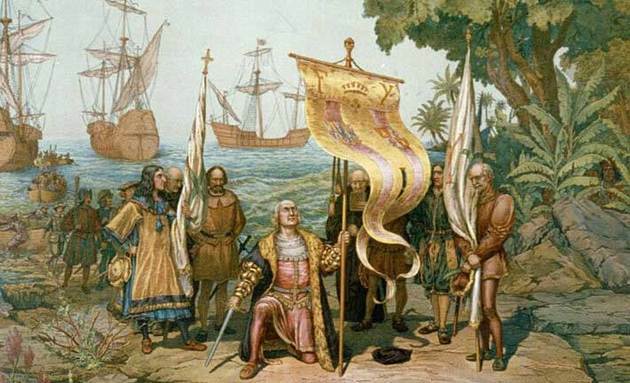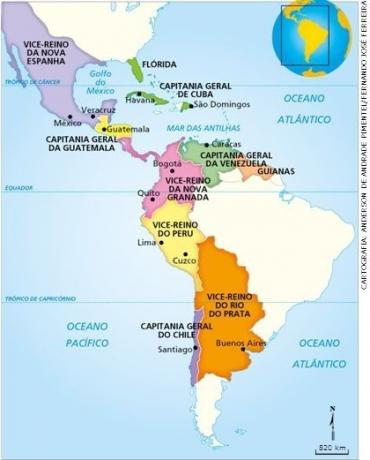spanish america or Hispanic America these are the names given to countries in Latin America that were colonies of the Spanish empire. Currently, these countries are distributed in South, Central and North America.
Cologne
The colonization process of the Americas began in 1492, with the arrival of the Italian navigator Christopher Columbus' squadron. In search of an alternative route to the Indies, Columbus lands in the Caribbean.
The territorial limits that would give rise to Spanish America began to be drawn two years after its discovery, in 1494, with the signature of the Treaty of Tordesillas. This agreement provided for the division of all new discovered and undiscovered territories between the kingdoms of Portugal and Spain.
After the conquest, Columbus himself was appointed governor of the new territories, but due to mismanagement, he was eventually removed in 1500.

In 1517, Spanish explorers ended a war against Muslims in the Iberian Peninsula and they turn hard to occupy territories discovered in America.
In the so-called “New World”, Spanish colonists found precious metals and these became the economic base of the colonies. Obeying the colonial pact, all the wealth taken from the colony was sent to the metropolis.
Indigenous and African slavery
The evangelizing spirit of the Catholic religion also led explorers to seek new souls for the Church. The natives were catechized and a great part abandoned their customs and another part, mixed their religions with Christianity.
In theory, it was forbidden to enslave the Indians. However, in practice, the natives were captured from their communities and distributed among the settlers to work in the mines. This practice existed among the Andean peoples and was called mit.
The settlers took diseases unknown to the indigenous people, such as smallpox, typhus, measles and flu, which caused a large number of deaths.
The Spaniards had an infinite military advantage in comparison with the native peoples and knew how to make alliances that pitted the indigenous tribes against each other.
In addition to stronger swords and gunpowder, they took horses to the new continent and began to have an intense advantage on the battlefield.
In this way, the natives succumbed to the colonizers. Entire empires were destroyed, such as the Mayans, Aztecs and Incas.
African slavery in Spanish America did not occur homogeneously. In the Caribbean, entire populations were decimated and replaced by black Africans.
However, in the Andean America, the use of indigenous and black Africans is registered, according to the task they should perform and the place where they should work.
Colonial Society

Colonial society was shaped through violence and miscegenation. As there were few Spanish-born women living in the colonies, the men united with indigenous people. Some marriages between the indigenous nobility and officials were performed with the aim of strengthening local alliances.
For this reason, there was a mixture of the European and the Indian and, later, the black. The latter to a lesser extent than in Brazil.
Spanish American society was basically divided into:
- Chapetones: they were the colonial elite, controlled the colony and held high administrative positions.
- Criollos: came right below. They were the sons of Spaniards born in the colony and were part of the nobility, being also great landowners.
- Blacks and Indians: they were at the base of the social pyramid.
Indigenous people would become marginalized, but many would maintain their ancestral customs.
Colonial Administration
The metropolis controlled the colonies through the Contracting House, which had its headquarters in Seville and, later, in Cádiz. There was also the Council of the Indies, which was responsible for the colonial administration and which was represented in the colonies by the hats.
Likewise, there were the cabildos, also called municipal councils. These councils represented the metropolis and controlled policing, tax collection, and justice.
the heads of cabildos they were chosen by the crown itself and were often for life. The people did not participate in the cabildos, but they were called when there were important decisions to make.
This situation was recorded when Napoleon invaded Spain in 1807 and King Ferdinand VII was arrested by French troops.
In the 18th century, Spain administratively reorganized its colonies in America. Therefore, the Viceroyalty of New Spain, Captaincy General of Guatemala, Captaincy General of Cuba are created, Captaincy General of Venezuela, Captaincy General of Chile, Viceroyalty of Nova-Granada and Viceroyalty of Rio da Silver.

Independence of Spanish America
The emancipation of the Spanish American colonies took place between 1808 and 1829. The uprisings were inspired by Enlightenment ideas, the example of the US liberation process and the desire to get rid of the high taxes levied by the Crown.
Success in the independence process was achieved after many wars throughout the territory. The revolutionaries also had the support of England, interested in new consumer markets and raw material suppliers.
After emancipation, the Viceroyalties and Captaincies General were fragmented into many territories and gave rise to several countries such as Uruguay, Paraguay, Bolivia, Argentina, Chile, Peru, Ecuador, Colombia, Venezuela, Panama, Cuba, Santo Domingo, Honduras, Costa Rica, Nicaragua, Guatemala, and Mexico.
Likewise, the Spaniards were in Puerto Rico and much of the territory that is now the United States such as the states of California, Texas, Florida, among others.
read more:
- discovery of america
- Latin America
- First Peoples of America
- Simon Bolivar
